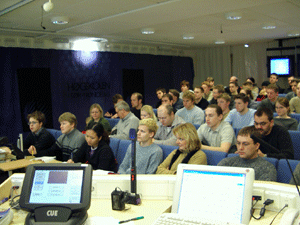1. Introduction

When designing and building digital classrooms, there are
several important details that should be addressed at the
first stage. The room should work properly for all categories
of users, i.e. the teacher, students present in the room and
students participating on videoconference at the far end part.
One of the most important and critical tasks is to define
the level of usage of the digital classroom, see the next
section.
Generally, it is more complicated to design and more expensive
to build classrooms with a high level of usage. In addition,
digital classrooms will often have combined levels of usage,
with some usage in two of the levels or, perhaps, all three
Choice of equipment and the room's functionality will be
influenced by the following factors:
- Definition of the room's primary and secondary level of
usage.
- How many people will be using the rooms and the systems?
- Who will operate and maintain the equipment: teachers,
local super users or suppliers?
- The room size (length, width, height), number of, and
placement of, windows, geo-graphical orientation etc. This
will influence the choice of monitors and projecting sur-faces,
speakers and microphone systems.
- The acoustic properties of the room.
- The light conditions of the room.
- Colours used on walls and fabrics, and colours on furniture.
One should try to achieve flexible solution with respect
to 1) furnishing and 2) size of projecting surfaces and monitors,
so that both big and small groups feel comfortable with the
solutions. Apparent eye contact with far end parts is achieved
by looking straight into the camera. The placement of cameras
with respect to monitors is therefore critical. As a general
requirement, the camera must be placed as near the monitor
of far end part as possible. It is decisive for the level
of involvement and inclusion of course participants that the
instructor looks directly into the camera most of the time.
An example: Think about the newsreader on TV. When he is looking
into the camera, we may feel that he is telling us something
rather than just reading a paper to us (which he actually
does).
For small rooms, monitors should not be too large, because
you will then look far away from the camera when you are looking
at the monitor where you see the far end part(s). In large
rooms it is recommendable to use more than one camera/monitor
system or projecting surface, to ensure good quality for different
sizes of groups.
|

